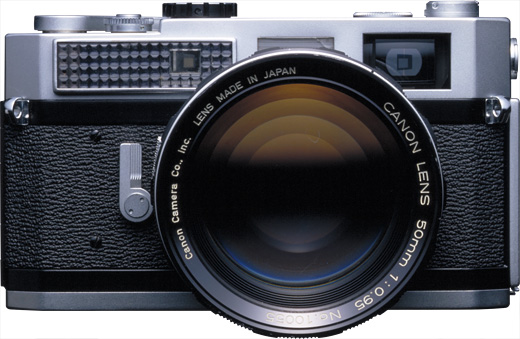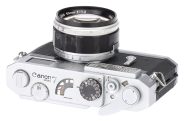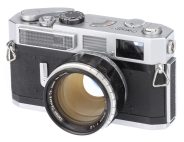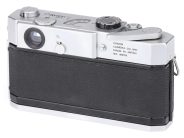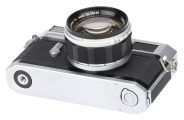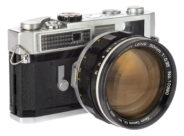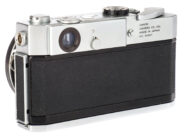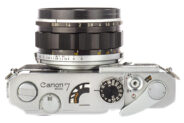Announced
Production status
System
Canon S (LSM) system cameras
- Canon 7
- Canon 7s
- Canon II-A
- Canon II-AF
- Canon II-AX
- Canon II-B
- Canon II-C
- Canon II-D
- Canon II-D1
- Canon II-D2
- Canon II-F
- Canon II-F2
- Canon II-S
- Canon II-S2
- Canon III
- Canon III-A
- Canon IV
- Canon IV-F (IV-S)
- Canon IV-SB
- Canon IV-SB2
- Canon L1
- Canon L2
- Canon L3
- Canon P
- Canon VI-L
- Canon VI-T
- Canon VL
- Canon VL2
- Canon VT
- Canon VT de luxe
Canon 7
35mm MF film rangefinder camera • Discontinued
Specification
| Format: | |
| 35mm full frame | |
Film type: | 135 cartridge-loaded film |
| Leica screw mount [28.8mm] | |
| Shutter: | |
Type: | Focal-plane |
Model: | Mechanical |
Speeds: | 1 - 1/1000 + B, T |
| Exposure: | |
Exposure metering: | Through the separate window |
Exposure modes: | Manual |
| Physical characteristics: | |
Weight: | 670g |
Dimensions: | 140x81x31mm |
Manufacturer description #1
Lens: Model 7 accepts Canon's unique bayonet-mount Canon lens 50mm F0.95, as well as all thread-mount Canon lenses from 25mm to 1000mm.
Shutter: All metal focal plane shutter. Single-pivot, rigid shutter speed dial equally calibrated from 1/ 1000th to 1 sec., B & T plus self-timer.
Exposure Meter: Built-in light meter coupled to shutter speed dial. Sensitivity range is from LV6 to LV19.
Finder: Universal viewfinder for 35, 50, 85, 100, and 135mm Canon lenses. Parallax error corrected automatically when focused.
Lens Mount: New dual mount takes all thread-mount Canon lenses as well as the new bayonet mount 50mm F0.95.
Focusing: Double-image superimposing system.
Film Wind: Single-stroke winding lever.
Exposure Counter: Self-resetting-type.
Film Rewind: Rapid crank system.
Film: Any 35mm film cassette.
Film Speed Indicator: ASA 6 to 400 (DIN 9 to 27) on the shutter speed dial.
Flash Synchronization: FP and MX synchronization. Continental-type flash socket.
Manufacturer description #2
The successor to the VI-series, this Canon camera was the first to have an Arabic numeral designation. Around 1961, the market for top-quality 35mm cameras was quickly shifting to SLR cameras. Although Canon had already marketed the Canonflex, it concluded that rangefinder cameras for quick shooting was still in strong demand. The 7 had a built-in exposure meter which cameras up to the VI did not have. The viewfinder featured projected frames matching lenses from 35mm to 135mm. The ultra-fast 50mm f/0.95 dream lens was also developed at the same time for the camera. Both the Canonet and the 7 were announced at the 7th Photokina.
From the Classic Camera magazine (February 1999)
Canon made its mark in the international photographic markets with its Leica format screw mount rangefinder cameras, and the Canon 7 represents the peak of this format's evolution both referred to the viewfinder system and the structure in general. Introduced in 1961, the Canon 7 was made in 135.000 examples up until 1964, when it was replaced by the 7S equipped with a CdS cell and very rare today as it was made in just 20.000 examples up until 1968.
It is a screw mount camera with an external bayonet mount, multi-focal, luminous frame viewfinder, selenium light meter and a steel blade shutter offering excellent performance even by today's standards.
The layout is typical of a rangefinder camera, with the controls to the right, following a trend that was also carried over in 35mm SLRs.
On the whole, the camera's lines are quite heavy, but charming nonetheless. From a practical point of view, on the other hand, the Canon 7 is easy to use and very stable.
The Canon 7 in detail
The film wind lever, frame counter, shutter speed selector, shutter release, light meter window, the viewfinder frame selector and film rewind lever crank, are all on the top plate. The double action film wind lever describes an arc of 170° and can be used in a single sweep or in additional movements. In its operative position it is offset from the camera body and appears aesthetically quite gawky, though very functional. An oversized knob, placed coaxially to the threaded shutter release is used as the shutter lock, plus with remote cables, and as the film release for rewind purposes, or finally, to cock the shutter for multiple exposures. These are facilitated by the easy to see frame counter which can easily be checked for unwanted movement of the film, which has to be kept in tension by means of the rewind lever.
A small button to release the film speed selector, which is quite difficult to operate, plus a switch for the two light metering scales and the viewfinder eyepiece are at the back of the camera. The camera back release key is placed at the left of the base plate under the standard synch socket for use in flash mode. The socket has a bayonet which engages with a Canon dedicated flashgun or an accessory bracket for standard flashguns or additional viewfinders. The key also doubles as a shaft to control the special Canon film cassettes which achieved light tightness without the usual velvet strips by means of complex counter rotating bushes. At the right of the base plate is a 1/4 inch screw thread for tripod mounting. This solution - strongly offset from the optical axis - is unjustified considering that the camera back opens on the side, but must have been maintained through force of habit.
The viewfinder and light meter
The luminous frame viewfinder with automatic parallax correction is excellent and can be switched to four positions, respectively covering 35mm, 85mm, 100mm and 135mm focal lengths via the control placed over the eyepiece. The rangefinder is at the centre of the frame; it is very accurate, but contrast is low and therefore is difficult to use.
The light meter makes use of a large selenium cell placed at the front of the camera, around the second rangefinder window; it is couple to the shutter speed but is not noted for ease of use and accuracy. On the other hand, an average light meter is better than no meter at all. The film speed scale - in DIN and ASA - is barely adequate, as it covers a range between 6 and 400 ASA. The EV range is also disappointing, ranging from 6 to 19 EV for a 100 ISO film. On the other hand, the high quality components - cell included - ensure that the device is very durable and is still perfectly functional in most Canon 7's even today. Its use is similar to that of any hand held device (its angle of view is similar to that of a standard lens): all the operator has to do is point it to the subject, read the aperture and transfer the setting to the lens.
The shutter
The shutter is an 18 micron steel curtain with a range of speeds between 1/1000s and 1s, plus B, T and X setting, specifically introduced for electronic flashguns as maximum synch speed. As was the norm for cameras of this period, synch is also calibrated on all speeds for flashbulbs (in particular, the FP and M models synch at all speeds except 1/30s, X and B; M models synch between 1/125s and Is except 1/125 and X; F models synch between 1/30s and Is, plus B setting). Releasing the shutter on T pose leaves the device open until the speed selector knob is moved.
At the front of the camera, bottom right is the mechanically operated self timer lever which has a delay of 10 seconds and is activated by the shutter release.
Lens mount and lenses
The lens is a six element 50mm f/1.4, but the camera could also be equipped with f/1.8, f/1.2 - and an impressive f/0.95 - standard lenses. The mount is the classic Leica format screw thread, modified by the addition of an external bayonet used to avoid vignetting when using the ultra fast f/0.95 standard lens or the Reflex Mirror Box 2 accessory. These days, finding an adequate range of all types of lens is quite easy. Staying in the Canon camp, the range of contemporary lenses for the Canon 7 extended to a 25mm wide-angle and a 1000mm super telephoto and most of these are easy to find.
On the accessory side, there is a range of additional lenses with viewfinder correction, and the already mentioned reflex box, while a little rarer are accessories such as a tripod mounting bracket, an additional accessory bracket, the repro accessory for copying and microscope photography.
Even today, it is easy to repair a Canon 7, with the exception of the light meter, for which parts are no longer made.
Similar cameras (43)
35mm full frame • Manual focus • Film • Rangefinder • Leica screw mount mount
| Model | Shutter | Metering | Modes | Year |
|---|---|---|---|---|
| Cosina Voigtlander BESSA-R | M, 1/2000 | TTL • WA | M | 2000 ● |
| Drug aka Друг |
M, 1/1000 | -- | M | 1960 ● |
| FED aka ФЭД |
M, 1/500 | -- | M | 1934 ● |
| FED-2 aka ФЭД-2 |
M, 1/500 | -- | M | 1955 ● |
| FED-2L aka ФЭД-2Л |
M, 1/500 | -- | M | 1969 ● |
| FED-3 aka ФЭД-3 |
M, 1/500 | -- | M | 1961 ● |
| FED-4[K] aka ФЭД-4[К] |
M, 1/500 | Window | M | 1964 ● |
| FED-5 aka ФЭД-5 |
M, 1/500 | Window | M | 1977 ● |
| FED-5S aka ФЭД-5с |
M, 1/500 | Window | M | 1977 ● |
| FED-5V aka ФЭД-5в |
M, 1/500 | -- | M | 1975 ● |
| Leica II (Model D) | M, 1/500 | -- | M | 1932 ● |
| Leica IIc | M, 1/500 | -- | M | 1948 ● |
| Leica IIf | M, 1/500 | -- | M | 1951 ● |
| Leica III (Model F) | M, 1/500 | -- | M | 1933 ● |
| Leica IIIa (Model G) | M, 1/1000 | -- | M | 1935 ● |
| Leica IIIb (Model G) | M, 1/1000 | -- | M | 1938 ● |
| Leica IIIc | M, 1/1000 | -- | M | 1940 ● |
| Leica IIId | M, 1/1000 | -- | M | 1939 ● |
| Leica IIIf | M, 1/1000 | -- | M | 1950 ● |
| Leica IIIg | M, 1/1000 | -- | M | 1957 ● |
| Leningrad | M, 1/1000 | -- | M | 1956 ● |
| Minolta-35 Model A | M, 1/500 | -- | M | 1947 ● |
| Minolta-35 Model B | M, 1/500 | -- | M | 1947 ● |
| Minolta-35 Model C | M, 1/500 | -- | M | 1948 ● |
| Minolta-35 Model D | M, 1/500 | -- | M | 1949 ● |
| Minolta-35 Model E | M, 1/500 | -- | M | 1951 ● |
| Minolta-35 Model F | M, 1/500 | -- | M | 1952 ● |
| Minolta-35 Model II | M, 1/500 | -- | M | 1953 ● |
| Minolta-35 Model IIB | M, 1/500 | -- | M | 1958 ● |
| Mir aka Мир |
M, 1/500 | -- | M | 1959 ● |
| Yashica YE | M, 1/500 | -- | M | 1959 ● |
| Yashica YF | M, 1/1000 | -- | M | 1959 ● |
| Zorki aka Зоркий aka ФЭД aka ФЭД 1948 Зоркий aka ФЭД 1949 Зоркий |
M, 1/500 | -- | M | 1948 ● |
| Zorki-2 aka Зоркий-2 |
M, 1/500 | -- | M | 1954 ● |
| Zorki-2S aka Зоркий-2С |
M, 1/500 | -- | M | 1955 ● |
| Zorki-3 aka Зоркий-3 |
M, 1/1000 | -- | M | 1951 ● |
| Zorki-3M aka Зоркий-3М |
M, 1/1000 | -- | M | 1954 ● |
| Zorki-3S aka Зоркий-3С |
M, 1/1000 | -- | M | 1955 ● |
| Zorki-4 aka Зоркий-4 |
M, 1/1000 | -- | M | 1956 ● |
| Zorki-4K aka Зоркий-4К |
M, 1/1000 | -- | M | 1972 ● |
| Zorki-5 aka Зоркий-5 |
M, 1/500 | -- | M | 1958 ● |
| Zorki-6 aka Зоркий-6 |
M, 1/500 | -- | M | 1959 ● |
| Zorki-S aka Зоркий-С |
M, 1/500 | -- | M | 1955 ● |
